
The African Queen is a 1951 British-American adventure film adapted from the 1935 novel of the same name by C. S. Forester. The film was directed by John Huston and produced by Sam Spiegel and John Woolf. The screenplay was adapted by James Agee, John Huston, John Collier and Peter Viertel. It was photographed in Technicolor by Jack Cardiff and has a music score by Allan Gray. The film stars Humphrey Bogart, and Katharine Hepburn with Robert Morley, Peter Bull, Walter Gotell, Richard Marner and Theodore Bikel.
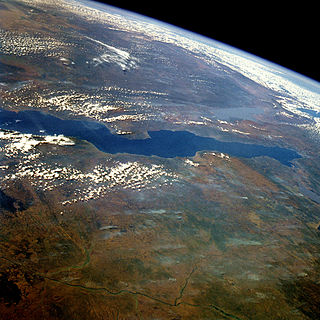
Lake Tanganyika is an African Great Lake. It is the second-oldest freshwater lake in the world, the second-largest by volume, and the second-deepest, in all cases after Lake Baikal in Siberia. It is the world's longest freshwater lake. The lake is shared between four countries – Tanzania, the Democratic Republic of the Congo (DRC), Burundi, and Zambia, with Tanzania (46%) and DRC (40%) possessing the majority of the lake. It drains into the Congo River system and ultimately into the Atlantic Ocean.

German East Africa (GEA) was a German colony in the African Great Lakes region, which included present-day Burundi, Rwanda, and the mainland part of Tanzania. GEA's area was 994,996 square kilometres (384,170 sq mi), which was nearly three times the area of present-day Germany, and double the area of metropolitan Germany then.
Mimi or MIMI may refer to:
Giles Foden is an English author, best known for his novel The Last King of Scotland (1998).

Kasanga, known as Bismarckburg during the German colonial rule, is a town in Rukwa Region, Tanzania. It is located at around 8°27′30″S31°8′10″E, on the shore of Lake Tanganyika, 810 m above sea level.

The African Queen is a 1935 novel written by English author C. S. Forester. It was adapted into the 1951 film of the same name.

Gustav Adolf Graf von Götzen was a German explorer and Governor of German East Africa. He came to Rwanda in 1894 at the head of a troop of 620 soldiers, becoming the second European to set foot in Rwanda, after Oscar Baumann, and later became the first European to cross the length of Rwanda. Götzen was the first governor of German East Africa.
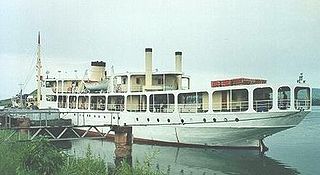
MV Liemba, formerly Graf Goetzen or Graf von Goetzen, is a passenger and cargo ferry that runs along the eastern shore of Lake Tanganyika. The Marine Services Company Limited of Tanzania sails her, with numerous stops to pick up and set down passengers, between the ports of Kigoma, Tanzania and Mpulungu, Zambia.

The East African campaign in World War I was a series of battles and guerrilla actions, which started in German East Africa (GEA) and spread to portions of Portuguese Mozambique, Northern Rhodesia, British East Africa, the Uganda Protectorate, and the Belgian Congo. The campaign all but ended in German East Africa in November 1917 when the Germans entered Portuguese Mozambique and continued the campaign living off Portuguese supplies.

Captain Geoffrey Basil Spicer-Simson DSO, RN was a Royal Navy officer. He served in the Mediterranean, Pacific and Home Fleets. He is most famous for his role as leader of a naval expedition to Lake Tanganyika in 1915, where he commanded a small flotilla which defeated a superior German force during the Battle for Lake Tanganyika.
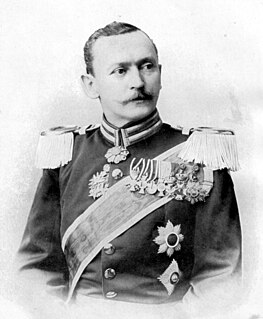
Hermann Wilhelm Leopold Ludwig Wissmann, after 1890 Hermann von Wissmann, was a German explorer and administrator in Africa.
HMS Mimi and HMS Toutou were motor launches of the Royal Navy. After undergoing an unusual journey from Britain to Lake Tanganyika in the interior of Africa, the ships played an important role in the African naval struggle between Britain and Germany during World War I. The names mean Meow and Fido in Parisian slang. They had originally been named Dog and Cat by their erstwhile commander, Geoffrey Spicer-Simson, only to have the names rejected by an apparently scandalized Admiralty.
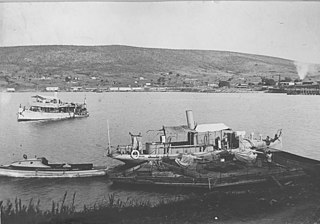
The Battle for Lake Tanganyika was a series of naval engagements that took place between elements of the Royal Navy, Force Publique and the Kaiserliche Marine between December 1915 and July 1916, during the First World War. The intention was to secure control of the strategically important Lake Tanganyika, which had been dominated by German naval units since the beginning of the war. The British forces — consisting of two motor boats named HMS Mimi and Toutou — were under the command of the eccentric Lieutenant-Commander Geoffrey Spicer-Simson. The boats were transported to South Africa and from there by railway, by river, and by being dragged through the African jungle, to the lake.

HMS Fifi was an armed screw steamer, captured from the Germans by Royal Navy units during the Battle for Lake Tanganyika, and used to support Anglo-Belgian operations on the lake and its surrounding areas. She had previously been operated by the Germans under the name Kingani named after the river Kingani.
The Holoholo people are an ethnic group that live around Kalemie city on Lake Tanganyika in the present-day Tanganyika Province of the Democratic Republic of the Congo, and on the opposite shore of the lake in Tanzania.

Hermann von Wissmann was a German steamer on Lake Nyasa named after the German explorer Hermann von Wissmann who had raised funds for the vessel to be built in 1890 as an anti-slavery gunboat.
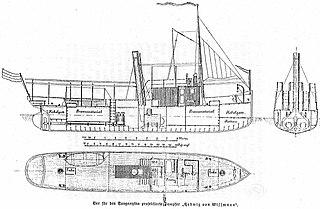
The Hedwig von Wissmann was a German steamboat on Lake Tanganyika, which became a feature in the story behind the film The African Queen. She was sister vessel to the larger Hermann von Wissmann on Lake Nyasa, and like that vessel originally used as a gunboat against slavers. Hedwig von Wissmann was the wife of the German explorer and colonial administrator Hermann von Wissmann who had raised funds for both boats.

HMS Niger was a torpedo gunboat launched in 1892, converted to a minesweeper in 1909, and sunk in 1914 by the German submarine SM U-12 near Deal.
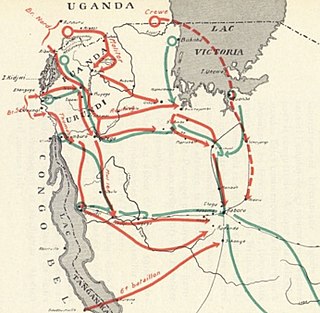
The Tabora Offensive was an Anglo-Belgian offensive into German East Africa, which ended with the Battle of Tabora in the north-west of German East Africa, it was part of the East African Campaign in World War I. The forces of the Belgian Congo crossed the border with German East Africa and captured the port city of Kigoma and the city of Tabora. In August a smaller Lake Force under the command of the South African brigadier general Crewe, launched a parallel attack from Uganda, also aimed at taking Tabora. The completion of the Tabora Offensive not only left much of the Ruanda-Urundi territory under Belgian military occupation but gave the Allies control of the important Tanganjikabahn railway.
















